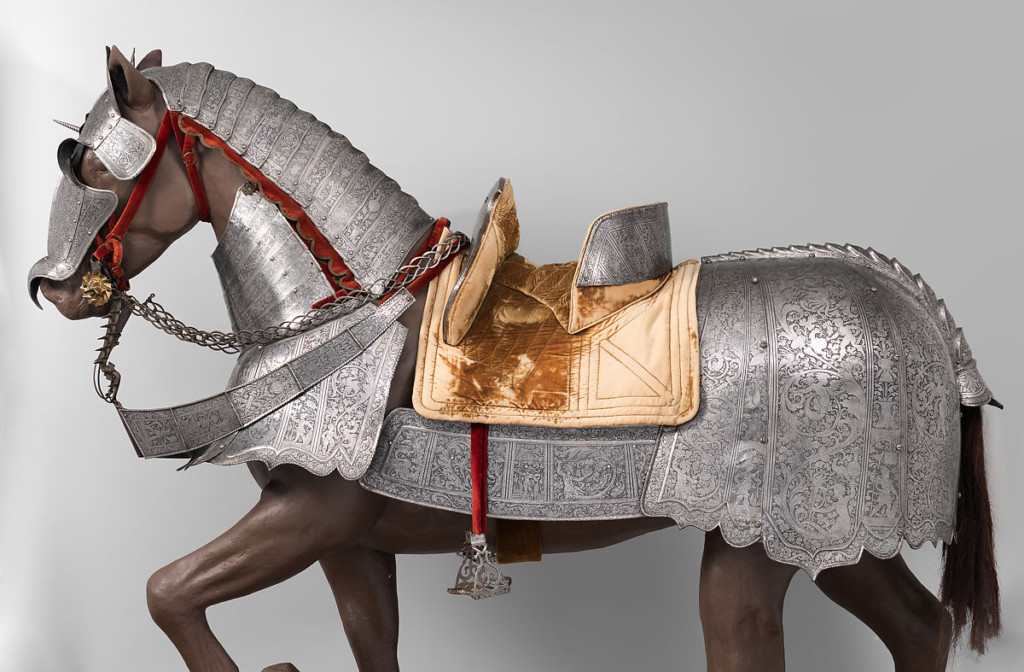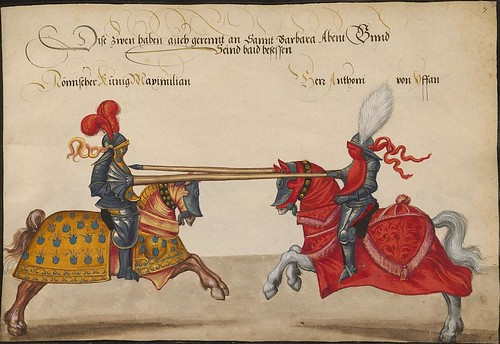When you picture the undertaking of wars of the past, there is one defining element that turned the tide of so many battles but is completely absent from modern warfare: the war horse. It was during the Medieval Era that the specialized war horse became a deciding factor on the battlefield – and when the ultimate evolution of man and horse as weapon hit its heights of refinement.

A good horse could cost as much as a fine house with a small plot of land.
While the trained knight would possess several horses, the one that is most iconically linked to war is the type called a destrier. The destrier was not any specific breed, but simply a work used to describe the overall shape, deposition and training of a horse. These mounts were usually kept intact as stallions, as this preserved the hot-blooded and aggressive tendencies that are seen in studs – enhanced with training to kick, bite and trample the enemy. In the 13th century, a well-trained destrier could cost about 80 pounds. The price of a very nice piece of property and well-situated house was about 90 pounds.
Teutonic knights were recorded to prefer geldings in battle – they were more level-headed than stallions and in the event that they were captured by the enemy their bloodlines could not be used to improve their own horse stock. While there were mares used in warfare in Europe, it was the Moors and the Mongols who preferred mares over stallions, the most obvious reason being that stallions quickly gave away positions of riders due to their constant calling and knickering.
Cutting off a horse’s tail was the ultimate insult
Docking – or amputating the horse’s tail – was seen as a means of casting public defamation and ridicule on the animal’s owner. There are many recorded instances of this sort of mutilation done during this period, when people widely believed that, like dogs, a horse would lower its tail between its legs in submission and fear – meaning that a horse without a visible tail would forever appear terrified and subservient to the Medieval eye. Horses belonging to Thomas Beckett had their tails lopped off on Christmas Eve in 1170 by Robert de Broc – Beckett was embarrassed enough by the actions to finish the Christmas Eve Mass by excommunicating de Broc and several of his associates. In French blazon, the term “defamed” was used to describe a warhorse who had his tail cut off. The Alfonsine codes allow for any knight whose horse had lost its tail in battle to choose a new animal, to avoid the “reciminating stares of his fellow warriors”.
War horses were not much taller than a pony
While many people look at breeds like the shire, Clydesdale and Percheron and see the perfect mount for a warrior, these horses are vastly different from those used by knights. These modern breeds are known as “draughts”, with essentially meant that they were developed purely for pulling heavy loads and working as a sort of precursor to the mechanized tractor. While strong at pulling, they horses are slow moving and lack the agility needed to maneuver a man in armor around in battle. The average destrier (the largest of the Medieval knight’s mounts) was likely only a little over 15 hands (152 cm). Horses standing at 14.2 hands (147cm) are considered ponies. The horse barding (horse armor) at the Royal Armory is displayed on a 15.2 hand model.
The horses that famously allowed the Normans to conquer at the Battle of Hastings were very similar to Arabians (short, slim but with a strong hindquarter, agile).

Horses had their own specially fitted out transport ships
Dromond styled ships were used to transport horses over seas. Renderings of Norman boats with horse heads peeking out of them are visible on the Bayeux Tapestries, showing the method by which horses were transported. Records of outfitting a ship to make a horse transport vessel are recorded under the rule of Edward III of England, and included adding stalls, installing iron rings (for leads to be tied to), canvas mangers, ample storage for feed and fresh water and four enormous gangplanks for loading and unloading of their precious cargo.
Each region produced a distinctive horse
Across Europe and the East, horses were being selectively bred for specific traits. While the concept of specific horse breeds were hundreds of years away, each culture influenced the type of horse they created, often embodying the ideals of each region respectively. Spanish horses were highly prized – the Iberian War Horse and Jenet were two imports that were very sought after.
“Horses be joyful in fields, and smell battles, and be comforted with noise of trumpets to battle and to fighting… And so feeleth and knoweth their enemies in battle so far forth that they a−rese on their enemies with
biting and smiting, and also some know their own lords, and forget mildness, if their lords be overcome: and some horses suffer no man to ride on their backs, but only their own lords. And many horses weep when their lords be dead.”
– Medieval Lore from Bartholomew Anglicus
Templar Knights could be punished for mistreating a horse
Many conjecture that the emblem of the Templar Knights, which shows two men riding a single horse, is a reference to the poverty in which the order was first created – they only had one horse for every two knights. Later Knights would be equipped with at least three horses – each for different tasks. There were a few grave punishments that could be meted out to Templar Knights by the order – one was called “Losing One’s Coat” which resulted in the removal of the characteristic habit they wore. On the list of ways a knight could be striped of their garments and status was through losing a horse due to negligence.

Saladin targeted Crusader horses
The Islamic military during the Crusades differed from that of the Europeans in one distinctive and pivotal way: they employed the use of horse-archers rather than knights. The horse archers would remain at a distance, moving quickly to dispatch their arrows. The European knight would create a line and charge into the enemy positions, effectively breaking them up and then turning and flanking them. If the knights could not reach their target, their strategy would be undone. Turkish horse-archers strategically targeted the horses of the Crusader knights, essentially taking out their most successful resource in battle. The horses are costly and difficult to replace – and a knight on foot no longer had the tank-like ability to smash opponents.
“Thus have horses been found that
in the thick of battle have shewn themselves as loyal to their masters as if they had been men. There are
horses who are so strong, fiery, swift and faithful, that a brave man, mounted on a good horse, may do
more in an hour of fighting than ten or mayhap a hundred could have done afoot.”
– Gutierre Díaz de Gámez
–
Bibiolography
Hyland, Ann. The Medieval Warhorse from Byzantium to the Crusades. Combined Books, 1996.
Gutierre Díaz de Gámez, and Joan Evans. “Part IV.” The Unconquered Knight: A Chronicle of the Deeds of Don Pero Niño, Count of Buelna, G. Routledge & Sons, London, 1928, p. 5.
Gravett, Christopher. English Medieval Knight 1300-1400, Oxford: Osprey Publishing, 2002, p 59
Hewitt, H.J. (2004) [1966]. The Organisation of War under Edward III. Barnsley: Pen & Sword.
Ralls, Karen. The Templars and The Grail. Quest Books, 2012.
Frendt, Cayman. “Twelfth Century Infantry Revolution: Horse-Archer Influences on European Tactics .” The Myriad, Westminster College, 2021.
Ayton, Andrew. Knights and Warhorses: Military Service and the English Aristocracy under Edward III. Boydell, 1994.
Miller, Andrew G. “‘Tails’ of Masculinity: Knights, Clerics, and the Mutilation of Horses in Medieval England.” Speculum, vol. 88, no. 4, The University of Chicago Press, 2013, pp. 958–95, http://www.jstor.org/stable/43576864.

brianstammVerified
Great article. Just an additional note. During the southern invasion of Pennsylvania in 1863, many draught horses confiscated ( or procured) by Confederate troops were thought to be valuable assets as artillery horses. The rebels soon found out that they could easily pull artillery pieces, however they lacked the speed needed to bring the cannons into battery quickly.
NiobeVerified
Unfortunately for the Confederates, horses in the rural areas were a bit like tractors back then. In the years surrounding the Civil War, new horse-driven methods of cultivating and harvesting were being widely adopted, like the reaper binder and these new and improved seed drills capable of planting several rows of crops at once. This increased the land a single farmer could cultivate in a year and they were dependent on a horse who had muscle and stamina – but that didn’t mean they had much get up and go. On a smaller farm or less rural area they might have encountered a dual purpose breed like the Morgan horse, that would have been lighter for riding – though still heavily muscled for pulling – with hot-blooded characteristics. This would have been more ideal for their purposes. That cold-blood aspect to the draughts/drafts make them very docile and sane, but rather slow.